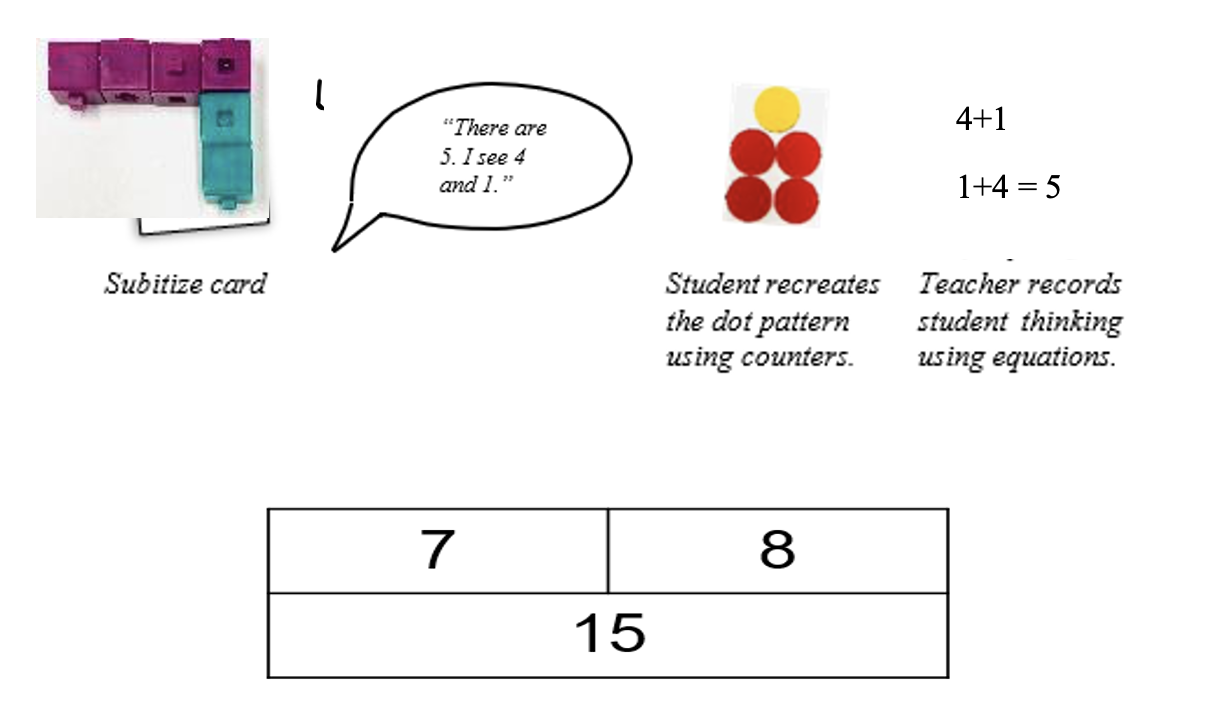General Information
Benchmark Instructional Guide
Connecting Benchmarks/Horizontal Alignment
- MA.K.NSO.1.1
- MA.K.NSO.1.2
- MA.K.NSO.2.1
- MA.K.NSO.2.2
- MA.K.NSO.2.3
- MA.K.AR.1.1
- MA.K.AR.1.2
- MA.K.AR.1.3
- MA.K.AR.2.1
Terms from the K-12 Glossary
- Equation
- Expression
- Number Line
Vertical Alignment
Previous Benchmarks
Next Benchmarks
Purpose and Instructional Strategies
The purpose of this benchmark is to begin building strategies for addition and subtraction using skills developed through previous benchmarks; such as counting forwards and backwards, counting objects and using number lines. Procedural reliability with addition and subtraction facts within 10 is expected in MA.K.NSO.3.2, and automaticity is to be achieved in grade 1.- Instruction encourages students to use and explore various strategies as they begin to discover which strategies are best for them and best for given situations (MTR.5.1, MTR.2.1).
- Strategies include the use of manipulatives; the use of fingers, counting both sets separately and combining or removing, counting on and counting back, and using the relationship between addition and subtraction.
- Instruction includes the use of manipulatives and pictorial representations.
- Instruction includes multiple representations of expressions and equations (MTR.2.1).
- For example, 6 + 7 = and = 6 + 7 and making the connections to the related subtraction of 13 – 6 =____ and __= 13-6. Instruction includes examples of all four situations for addition and subtraction as described in Appendix A.
- Instruction includes the use of context to provide a purpose for adding or subtracting, and to develop conceptual understanding for addition and subtraction (MTR.7.1).
Common Misconceptions or Errors
- Students may confuse addition situations with subtraction situations based on “cue” or “key” words.
- For example, in the word problem “Steve has 7 crayons. Steve has 3 more crayons than Joane. How many crayons does Joane have?” the word “more” may make students think to add, though the context is actually subtraction.
- Students may think there is only one correct way of solving a problem. Many problems can be solved by using addition or subtraction.
- After mastering one addition or subtraction situation students may feel that there are no others to learn.
Strategies to Support Tiered Instruction
- Instruction includes opportunities to use various manipulatives to model addition and subtraction situations and record the equations being modeled. Instruction can include physically breaking apart a whole to model subtraction equations.
- For example, teachers include an emphasis on discovering the commutative property, or that numbers can be added in any order and that the sum will remain the same.

- Instruction includes removing the equation symbols to both isolate and focus on the concept that two parts combine to make a whole. To support language development of equation representations, describe the concepts of adding to and taking away as “8 and 7 make 15” or, “15 take away 8 is 7.” Students could also use counters inside the part-part-whole organizer to model the situation.
- Teacher provides opportunities for subitizing tasks in which cards with dot patterns can be used to visualize the pattern and describe the way it is seen. Teacher records the combinations of numbers that students use to help make their thinking visual.
- For example, subitize cards can include dots with two different colors to enhance distinction between quantities within a total.
- For example, students may use counters to match the dot patterns on the cards and record an equation that matches.

Instructional Tasks
Instructional Task 1 (MTR.4.1)
In a small group, provide students with various tools for adding and subtracting (i.e., number lines, counters, bears, paperclips, paper and crayons). Present an expression, both verbally and in written form, and instruct students to find the sum or difference using any tool or strategy they feel comfortable with. Once everyone is comfortable with their solutions, allow students the opportunities to share their solutions and methods. Use the sharing as an opportunity to discuss various methods and strategies, being sure to validate each. Efficiency is not the goal here, so any accurate strategy is valid, especially when it deepens understanding.
Instructional Items
Instructional Item 1
To count the flowers shown to the right, James recognized that there are 4 orange flowers and 2 pink. He started at 4, then he counted on, “5, 6,” to find that there are 6 total flowers.- How could you use James’s strategy to find 6 + 3?
- How many orange flowers are there?
- How many pink flowers are there?
- How many flowers are there in all?
Instructional Item 2
Ashley and Larry are coloring a picture. Ashley has 9 crayons and Larry has 4 crayons. How many crayons do they have?*The strategies, tasks and items included in the B1G-M are examples and should not be considered comprehensive.

